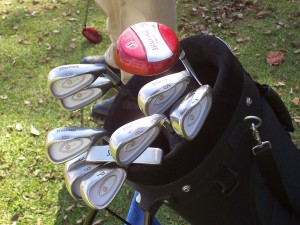There is no reason for amateur golfers to continue to rely on on-course yardage markers in today’s world. Marking off the actual yardage from your ball to a yardage marker is inaccurate and time consuming. There are two distinctly different devices available on the market to help you determine yardage on the course; the golf GPS system and the laser rangefinder.
Which one is right for the beginner or high handicap golfer?
First, let’s take a detailed look at each.
Golf GPS systems utilize the same GPS satellite system that a car navigation system does. GPS coordinates must be mapped for each course that the manufacturer offers on the device. This is primarily done through the use of satellite images but Sky Golf, maker of Sky Caddie systems, prides itself on walking every course. The accuracy of a golf GPS system is usually within a few yards with the Sky Caddie systems claiming even better accuracy. Using these GPS coordinates, the device can tell you the distance from your ball to various points on the hole. The most basic of systems tell you the distance to the center of the green. Most tell you at least the distance to the front, center, and back of the green while some offer more including the distance needed to carry hazards. An overhead view of the hole is another feature on some systems. Most of the touchscreen models offer the ability to drag to any point on the hole and see the distance to it.
A laser rangefinder shoots a laser off an object to determine the distance to it. By far the biggest benefit of a laser rangefinder is its accuracy in measuring the distance to the flag. Several rangefinders boast of accuracy within one yard or less. A secondary advantage of some rangefinders is the ability to determine the slope from your ball to the target and factor it into the distance. So if the actual distance is 150 yards but the target is uphill, the device would also give a longer “play-as” yardage. Rangefinders are also able to lock onto targets other than the flag, although this can sometimes be trickier and take more time. The major drawback of a laser rangefinder is the fact that it cannot measure the distance to a target that it cannot see. So any blind shots are not measurable.
So which device is better for the high handicap or beginner golfer?
A golf GPS system is the best choice for the beginner or high handicap golfer. There are several reasons why.
- The goal of a high handicap golfer is to hit greens in regulation – not to go for every flag. Many times holes are guarded by hazards and the safe play is an area of the green away from the hole. A golf GPS system that tells you the distance to the front, center, and back of the green will help you think of the distance remaining to the green as a yardage range instead of a specific yardage, helping you hit more greens.
- Many golf GPS systems show an overhead view of the hole. Visualization is a crucial component of being a successful golfer. An overhead view of the hole is highly beneficial in utilizing course management to plan out your shots on each hole.
- A golf GPS system is quicker than a laser rangefinder. Slow play is becoming an increasingly larger problem in golf. It takes time to zero in on a target with a laser rangefinder. A GPS will instantly tell you the remaining yardage to the green.
- You can keep score and track stats on many golf GPS systems. In addition to determining yardage left to the green and hazards, many golf GPS systems allow you to keep score and track stats.
While hopefully someday your golf game will progress to a level that requires the accuracy of a laser rangefinder, it is simply not necessary at the high handicap level. The added benefits of a golf GPS system make it the easy choice for the beginner or high handicap golfer.


